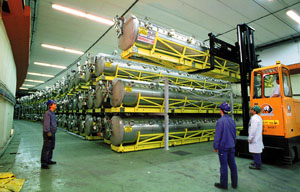
The imaginations of physicists all over the world have been fired by the quest for new schemes for making intense beams of neutrinos. Attention is now turning to the proton machines that may be able to provide these synthetic particles. At established laboratories like CERN, developing such proton drivers would offer new possibilities for boosting existing beam networks, as well as benefiting future ones.
The new idea involves muon storage rings. The first step is to use high-energy protons to produce pions, which decay to give muons. These are then quickly accelerated (their lifetime at rest is only 2 µs) and passed to a storage ring, where they decay. The key requirement is for a very intense proton accelerator that can deliver several megawatts of beam power.
At CERN, this has generated increased interest in the idea of a Superconducting Proton Linac (SPL), which had already been proposed as a new injector for the 28 GeV Proton Synchrotron (PS). The PS is CERN’s oldest machine, but it remains the heart of the laboratory’s unique particle beam system.
To deliver its 2.23 GeV protons, the SPL, operating at 352 MHz, would use radiofrequency equipment salvaged from CERN’s LEP electron-positron collider, which was closed at the end of last year. The SPL would in fact handle negative hydrogen ions (two electrons orbiting each proton), the classic medium for eventually supplying high-energy protons.
All 44 of the klystrons that previously powered LEP’s accelerating structures would be reused. They would operate in pulsed mode with a 30% duty cycle. Over the 800 m of the proposed linac design, the last 360 m (above a kinetic energy of 1085 MeV) would be equipped with 108 unmodified LEP-2 radiofrequency cavities. Between 390 and 1085 MeV, 12 LEP cryostats would also be employed, refurbished with new five-cell cavities. Suitable resonators would have to be developed for the lowest energy range.
Upstream, room temperature structures would be used, namely radiofrequency quadrupoles to supply the initial energy kick up to 7 MeV, and drift tube linacs up to 120 MeV. The linac would inject into an accumulator ring and then a bunch compressor ring before the tailored beam reaches the pion production target.
Such a high-power machine brings special design considerations. Electrical power increases with the repetition rate of the machine, and a compromise value of 75 Hz has been selected. Short proton bunches are needed to maximize the density of the muons, and the requisite 1 ns levels are difficult to achieve. However, deleterious effects are minimized by limiting the number of protons per bunch to 3.3 x 108, using 140 bunches spaced by 23 ns.
The SPL would supply beams to the PS, and thence to the SPS and the LHC. Higher-performance beams could be delivered by the PS, thanks to the increased injection energy and higher density of the injected beam. This would have knock-on benefits for all of CERN’s machines, including the neutron time-of-flight facility and the antiproton decelerator.
Another happy SPL client would be the ISOLDE on-line isotope separator, especially in view of the ambitious plans of this physics community, which is looking for such a proton accelerator to drive the next-generation facility in Europe.





